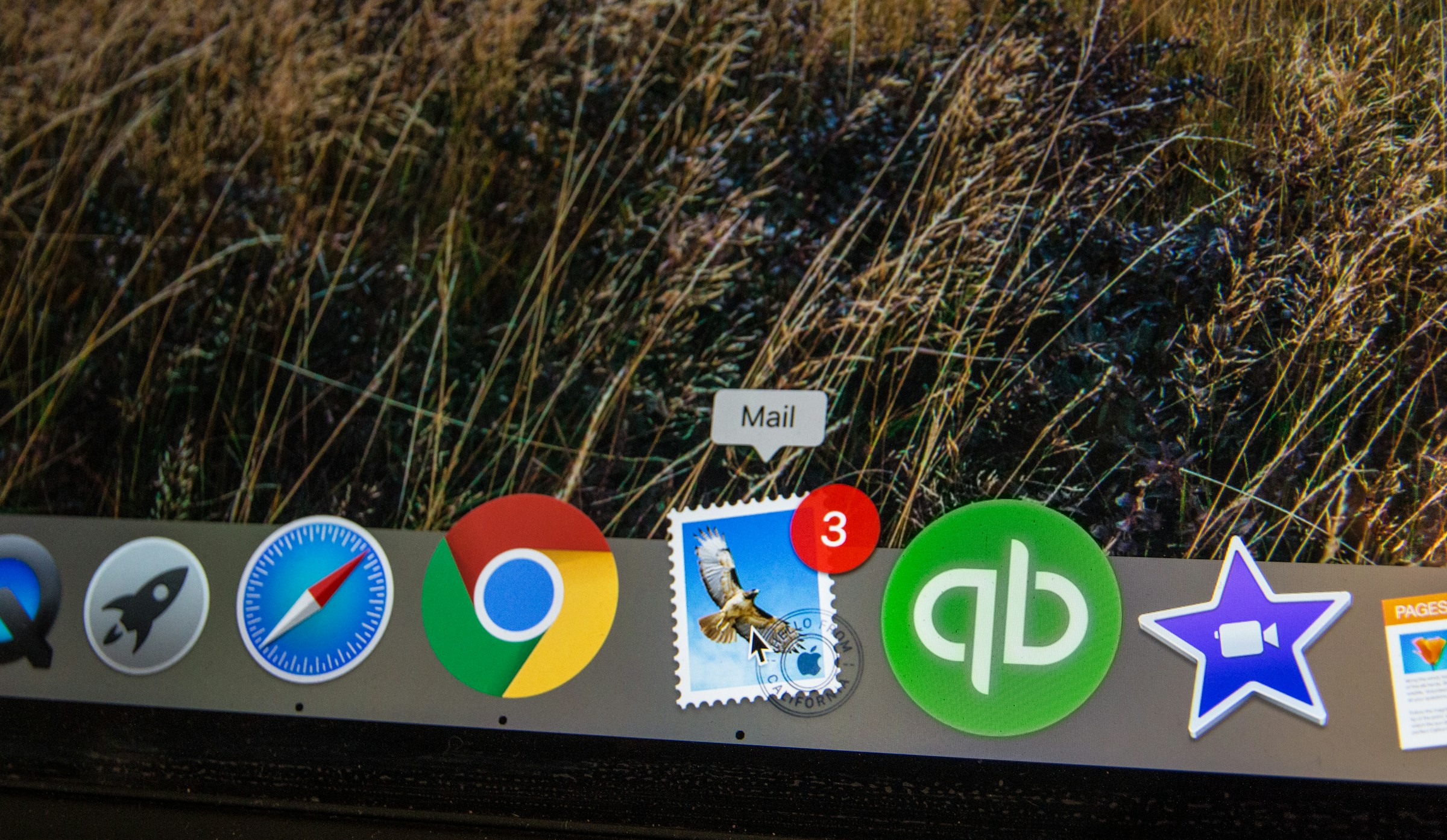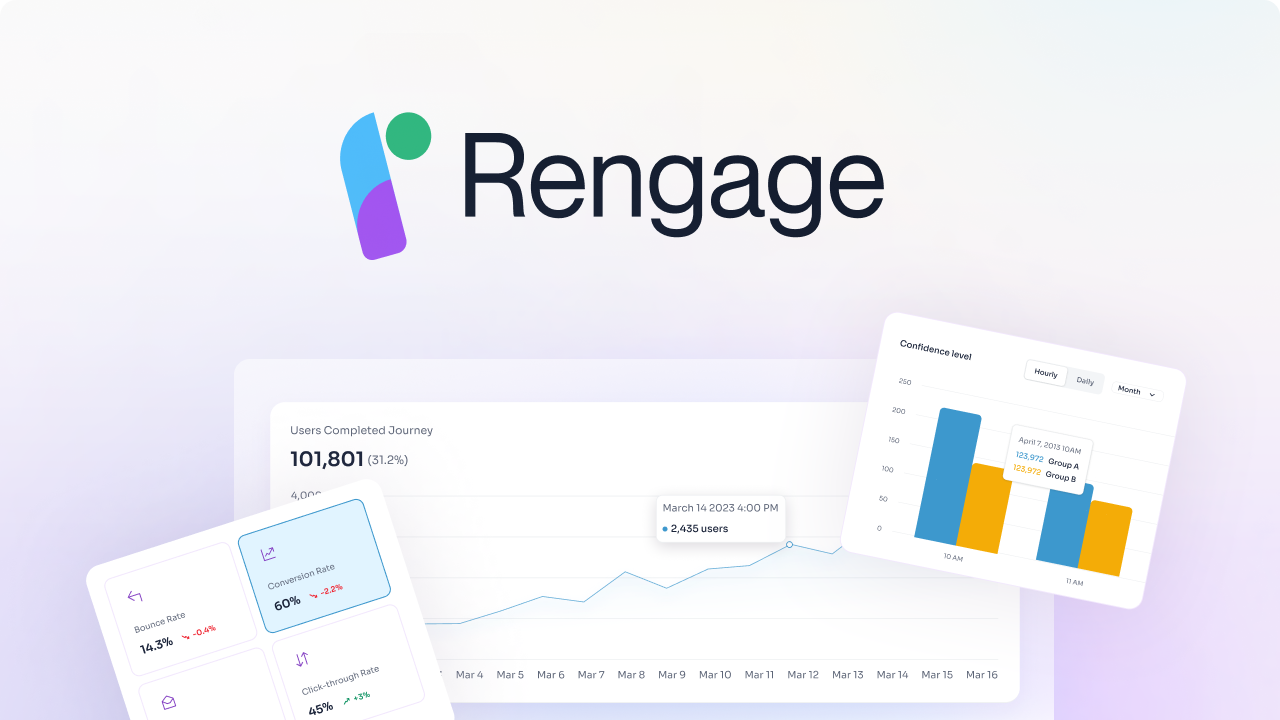10 Getresponse Alternatives (2024)
Are you seeking Getresponse alternatives to enhance your omnichannel customer experience? Imagine seamlessly streamlining your marketing efforts across various platforms to reach your target audience. This article can help you explore ten valuable options to revamp your marketing strategy effectively.
Rengage's omnichannel marketing platform could be the ideal tool to help you achieve your goals, such as finding other Getresponse alternatives. With its user-friendly features, you can effortlessly transition from one platform to another to maximize your marketing potential.
What is Email Marketing and Why is it Important?

Email marketing is a digital marketing strategy involving sending promotional messages, transaction notifications, and other marketing content to an audience via email. It’s a powerful tool for businesses of all sizes to:
- Build customer relationships
- Generate leads
- Drive sales
The effectiveness of email marketing lies in its ability to reach a wide audience directly, allowing for personalized communication and measurable results.
The Role of Email Marketing Automation
Email marketing automation involves using software to streamline and automate email marketing tasks, such as:
- Sending personalized emails
- Managing email lists
- Tracking campaign performance
Automation saves time, increases efficiency, and improves campaign effectiveness by enabling marketers to focus on strategy and analysis rather than manual tasks.
Challenges Faced by Email Marketers
Email marketers face several challenges, including:
- High competition: With a crowded inbox, standing out can take time and effort.
- Deliverability issues: Emails ending up in spam folders can reduce reach.
- Measuring ROI: Determining the effectiveness of email campaigns can be challenging.
- Staying compliant with regulations: Adhering to anti-spam laws and data privacy regulations is crucial.
- Keeping up with technology: The email marketing landscape is constantly evolving.
Overview of GetResponse and its Limitations
GetResponse is a popular email marketing platform offering a range of features, including email creation, automation, landing pages, and webinars. While it’s a solid choice for many businesses, it may not fit everyone best. Some limitations include:
- Potential scalability issues for large businesses
- Limited advanced automation features compared to some competitors
- Varying user experiences based on plan level
Understanding Your Email Marketing Needs
Clearly defining your target audience is essential for creating effective email campaigns. Understanding their demographics, interests, and preferences will help you tailor your content and messaging. Once you know your audience, you can set specific goals for your email marketing efforts, such as:
- Increasing sales
- Generating leads
- Building brand awareness
- Improving customer engagement
Budgeting for Your Email Marketing Software
Email marketing software comes in various price points, so setting a budget before starting your search is essential. When determining how much you can spend, consider the size of your email list, the features you need, and your overall marketing budget.
Related Reading
- Omnichannel eCommerce
- Omnichannel Marketing Strategy
- Omnichannel Personalization
- Omni Channel Marketing Examples
- Omni Channel Customer Engagement
- Omnichannel Marketing Tools
- Omnichannel Marketing Automation
- Omnichannel CRM
- Multichannel Marketing Automation
- Marketing Automation ROI
How to Identify Key Features for Your Email Marketing Platform

Email Creation and Design
A user-friendly drag-and-drop interface is vital to creating eye-catching campaigns. Templates also play a crucial role here, allowing you to save time and create professional-looking emails for various occasions. Responsive design ensures your emails look good on any device. Meanwhile, image optimization and HTML editing provide flexibility and boost loading times.
Email Automation
Automated emails are crucial for timely responses to customer behavior. Autoresponders and workflow automation take care of this. Personalization features like segmentation and trigger-based emails ensure your emails hit the right spot with your contacts.
Contact Management
Managing contacts effectively is key in any email marketing strategy. Import/export features and contact segmentation help organize your contacts. Custom fields and contact scoring provide valuable insights into your audience, while data cleaning ensures a clean list for improved deliverability.
List Segmentation
Segmenting your list according to different criteria is essential for targeted campaigns. Dynamic segmentation ensures your lists are always up-to-date, while A/B testing enables you to optimize your campaigns even further.
Email Deliverability
It is crucial to ensure your emails land in your recipients' inboxes. Domain authentication, content filtering, bounce management, and complaint management all contribute to maintaining a good sender reputation and high deliverability rates.
Analytics and Reporting
Tracking your email performance is integral to improving your campaigns. Key metrics to monitor are open rates, click-through rates, conversion rates, bounce rates, and unsubscribe rates. Customizable reports let you view your data in the way that is most useful to you.
Additional Features to Consider
Integrations with other marketing tools can enhance your campaigns, while a landing page builder ensures a seamless user experience. Features like A/B testing, SMS integration, mobile optimization, email scheduling, subscription management, and reliable customer support are worth considering.
Getresponse Marketing Platform (What it is & How it Works)

While GetResponse offers a robust suite of features, some businesses may have better solutions. Here are some reasons why users might consider exploring other options:
Pricing
GetResponse's pricing structure might not align with the budget of all businesses, especially smaller ones or those with rapidly growing subscriber lists. This could lead some users to explore other platforms that offer more cost-effective solutions or better value for money.
Feature Set
While GetResponse provides a comprehensive range of tools, some users may require more specialized features or integrations unavailable on the platform. For example, businesses heavily focused on ecommerce might need more advanced features for product recommendations and cart abandonment recovery.
Exploring other alternatives could provide access to the tools needed for a particular business niche or industry.
Scalability
As a business grows, its email marketing needs may evolve. GetResponse might be unable to accommodate the increased demands of larger email lists, complex automation workflows, or higher sending volumes. Users looking to scale their marketing efforts might find other platforms more suitable for their growing needs.
User Experience
User preferencesfor interface design, workflow, and overall usability vary. Some users might need help navigating GetResponse's interface. Exploring alternative platforms could lead to a solution with a more intuitive interface and smoother user experience.
Customer Support
The quality of customer support is a critical factor for many businesses. Issues with response times, problem resolution, or knowledge base resources can lead to frustration and a search for alternative platforms. Users needing better customer support services might turn to other options that offer more responsive and helpful support teams.
Integration Capabilities
Seamless integration with other marketing and sales tools is essential for many businesses. If GetResponse lacks the necessary integrations, it might hinder overall efficiency and data management. Exploring other alternatives could lead to finding a platform that offers better compatibility with existing tools and systems.
By carefully evaluating these factors, businesses can determine if GetResponse fits their specific needs or if exploring alternative options would be more beneficial.
Top 10 GetResponse Alternatives (2024)
1. Rengage

We provide a comprehensive solution for managing and enhancing customer journeys, delivering insights and measurable outcomes with no code. We accelerate your customer journey from onboarding, activation to conversion and churn. Enabling customers to unlock revenue from their existing user.
With [Rengage]https://rengage.ai), you can get insights into your segments, run campaigns with an intuitive journey manager, and get insights to measure how your journeys impact users conversion through our Journey Moments and Journey Builder features.
- Journey Moments: insights into your micro-segments
- Journey Builder: intuitive multi-channel marketing automation
- Insights prediction and attribution.
Book a free demo to transform customer interactions into personalized experiences that drive loyalty and growth with our omnichannel marketing platform.
2. ActiveCampaign
ActiveCampaign shines in marketing automation, offering advanced features like lead scoring, predictive analytics, and complex workflow automation. Its strong segmentation capabilities allow for highly targeted campaigns.
How It Works
Users create contacts and segments, design emails, and build automated workflows based on customer behavior. The platform offers in-depth analytics to track campaign performance and ROI.
Best For
Businesses focused on lead nurturing and conversion optimization.
Considerations
Pricing can be higher than some alternatives, and the platform might have a steeper learning curve due to its advanced features.
3. HubSpot
As a comprehensive marketing, sales, and CRM platform, HubSpot offers a holistic approach to customer relationship management. Its email marketing features include automation, personalization, and A/B testing.
How It Works
Users manage contacts, create email campaigns, and track customer interactions across multiple channels. The platform integrates with other HubSpot tools for a unified customer view.
Best For
Businesses seeking a comprehensive marketing solution and those already using HubSpot for other marketing or sales activities.
Considerations
Pricing can be steep for small businesses, and the platform's breadth might require a longer learning curve.
4. ConvertKit
Designed for creators and bloggers, ConvertKit offers a clean interface and focuses on email list growth and management. It excels at creating email courses and delivering valuable content.
How It Works
Users import subscribers, create email sequences, and design visually appealing emails. The platform offers basic automation features and in-depth analytics.
Best For
Content creators, influencers, and businesses selling digital products.
Considerations
Limited advanced automation features compared to other platforms.
5. Constant Contact
Known for its user-friendliness and strong customer support, Constant Contact is popular for small businesses and nonprofits. It offers basic email marketing features and design templates.
How It Works
Users create email lists, design campaigns using drag-and-drop, and send emails. The platform provides basic automation and analytics.
Best For
Small businesses and nonprofits seeking a user-friendly platform with reliable support.
Considerations
Automation capabilities might be limited compared to other options.
6. Sendinblue (now Brevo)
Sendinblue offers a multi-channel approach, combining email marketing with SMS, chat, and CRM. It provides automation, transactional emails, and marketing automation features.
How It Works
Users create contact lists, design email campaigns, and manage multiple communication channels. The platform offers advanced segmentation and automation capabilities.
Best For
Businesses looking for a multi-channel approach to customer engagement.
Considerations
The platform's breadth might require a learning curve.
7. Zoho Campaigns
Integrated with the Zoho productivity suite, Zoho Campaigns offers affordable pricing and basic email marketing features. It's suitable for businesses already using Zoho products.
How It Works
Users create email lists, design campaigns, and send emails. The platform offers basic automation and analytics.
Best For
Businesses already using Zoho products and budget-conscious marketers.
Considerations
Feature set might be limited compared to some competitors.
8. Omnisend
Designed specifically for e-commerce businesses, Omnisend offers features such as product recommendations, abandoned cart recovery, and SMS marketing.
How It Works
Users integrate their online store, create email campaigns, and leverage automation based on customer behavior. The platform provides in-depth analytics for ecommerce performance.
Best For
Online stores looking to boost sales through email marketing.
Considerations
Might not be the best fit for businesses outside ecommerce.
9. MailerLite
MailerLite offers a user-friendly interface, affordable pricing, and a focus on email design. It's suitable for small businesses and startups.
How It Works
Users create email lists, design campaigns, and send emails. The platform provides basic automation and landing page builder features.
Best For
Small businesses and startups on a budget.
Considerations
Feature set might be limited for large-scale campaigns.
10. Mailchimp
Mailchimp's user-friendly interface and free plan have made it a staple for small businesses and bloggers. Its strong brand recognition and extensive feature set, including email design, automation, and analytics, make it a solid choice for beginners.
How It Works
Users create email lists, design campaigns using drag-and-drop builders, and schedule or send emails immediately. Automation features allow for basic autoresponders and segmented campaigns. Analytics provide insights into campaign performance.
Best For
Small businesses, bloggers, and nonprofits starting out.
Limitations
While suitable for beginners, Mailchimp might lack advanced features for scaling businesses. Automation capabilities can be limited compared to other platforms.
Email Marketing Best Practices

Crafting Effective Email Campaigns
Crafting effective email campaigns is essential for engaging your audience and driving action. Several key elements must be considered to create compelling emails.
Crafting Compelling Subject Lines
Clear and concise subject lines are crucial for grabbing attention and enticing recipients to open your email. An engaging subject line sets the tone for the rest of the email and can significantly impact open rates.
Enhancing Visual Appeal with Engaging Graphics
Engaging visuals such as high-quality images and graphics can help enhance your message and make your email more visually appealing. Visuals can help to break up large blocks of text and draw attention to key elements of your message.
Strong Calls to Action
Strong calls to action (CTAs) are essential for guiding recipients to take the desired action. Your CTAs should be clear, compelling, and easy to follow whether your goal is to:
- Drive website traffic
- Promote a sale
- Encourage social shares
Personalization for Improved Engagement
Personalized content can also help increase engagement and drive conversions. By tailoring your emails to specific audience segments, you can create more relevant, targeted messages that resonate with recipients.
Mobile Optimization for a Seamless User Experience
Mobile optimization is essential for ensuring your emails are visually appealing and easily read on mobile devices. With more and more people checking their emails on smartphones and tablets, creating mobile-friendly emails that provide a seamless user experience across devices is crucial.
Building and Growing Your Email List
Building and growing your email list is critical for the success of your email marketing efforts. With a robust email list, you will have someone to send your carefully crafted email campaigns to. There are several effective strategies for building an email list.
Lead Magnets for Email Sign-Ups
Lead magnets are one popular tactic for incentivizing email sign-ups. You can attract more subscribers to your list by offering valuable content such as:
- eBooks
- Whitepapers
- Exclusive offers
Contests and Giveaways to Boost Email List Growth
Contests and giveaways are another effective way to encourage sign-ups. By running a contest or giveaway with an attractive prize, you can incentivize people to join your email list.
Pop-ups and Embedded Forms for Capturing Leads
Pop-ups and embedded forms on your website can also help capture visitor information and grow your email list. By strategically placing sign-up forms on your site, you can increase the number of people who opt-in to your emails.
Pop-ups and Embedded Forms for Capturing Leads
Social media promotion is another effective strategy for growing your email list. By encouraging your followers to subscribe to your email list on platforms like Facebook, Twitter, and Instagram, you can reach a wider audience and attract more subscribers.
Referral Programs for Leveraging Existing Subscribers
Referral programs are a great way to reward existing subscribers for recommending your business to friends and family. By offering incentives such as discounts or exclusive referral content, you can turn your existing subscribers into brand ambassadors who help grow your email list.
Improving Email Deliverability
Deliverability is critical in email marketing success. If your emails aren't getting delivered, they won't be read, clicked on, or converted. Several key strategies can improve email deliverability.
Authenticating Your Domain for Improved Deliverability
Authenticating your domain can help verify the authenticity of your emails and improve deliverability. You can ensure that your emails are correctly identified as coming from your organization by implementing:
- Sender Policy Framework (SPF)
- DomainKeys Identified Mail (DKIM)
- Domain-based Message Authentication, Reporting, and Conformance (DMARC)
Maintaining a Clean Email List
Maintaining a clean email list is also essential for improving deliverability. Regularly removing inactive or invalid email addresses can improve your sender's reputation and increase the likelihood that your emails will reach recipients' inboxes.
Avoiding Spam Triggers to Increase Inbox Placement
Another critical strategy for improving deliverability is to avoid spam triggers. Refraining from using excessive exclamation points, all caps, or deceptive subject lines can improve your chances of landing in the inbox instead of the spam folder.
Building a Strong Sender Reputation
Building a solid sender reputation is another effective way to improve deliverability. You can build trust with recipients and inbox providers by consistently delivering valuable content and avoiding sending unsolicited emails.
Monitoring Email Engagement for Performance Optimization
Monitoring email engagement metrics can help you identify potential deliverability issues and adjust to improve performance. By tracking open rates, click-through rates, and bounce rates, you can gain insight into how your emails are performing and make data-driven decisions to optimize your campaigns.
Specialized Email Marketing Platforms

Ecommerce-Focused Platforms
Platforms like Klaviyo and Omnisend excel for online stores. These tools leverage customer behavior, purchase history, and product preferences to deliver highly personalized email campaigns. Features like abandoned cart recovery, product recommendations, and automated post-purchase follow-ups are tailored to boost e-commerce sales and customer loyalty.
Small Business and Non-Profit Platforms
Businesses and nonprofits often seek user-friendly and affordable solutions. Constant Contact and MailerLite fit this profile. They offer essential email marketing features without overwhelming users with complex functionalities. These platforms are ideal for those who prioritize simplicity and cost-effectiveness.
Automation-Centric Platforms
For businesses prioritizing marketing automation, ActiveCampaign and HubSpot are strong contenders. These platforms excel at lead nurturing, lead scoring, and creating complex automated workflows. While HubSpot is a comprehensive marketing platform, ActiveCampaign focuses on marketing automation.
Other Notable Platforms
ConvertKit
Tailored for creators and bloggers, ConvertKit offers simple email automation and list management features.
Sendinblue
This platform combines email marketing with SMS, providing a multi-channel approach.
Zoho Campaigns
Integrated with the Zoho productivity suite, it offers a comprehensive solution for businesses using other Zoho applications.
Personalized Email Marketing with Customer Journey Insights
Rengage could be a powerful alternative to these platforms, especially for businesses seeking a deep understanding of customer journeys and behavior. Rengage can help businesses create highly personalized and effective email campaigns by combining customer journey insights with robust automation capabilities.
Related Reading
- Omnichannel Marketing Trends
- Challenges In Omnichannel Commerce
- Omnichannel Marketing Software
- Omnichannel Customer Experience Examples
- Benefits of Omnichannel Marketing
- B2B Omnichannel Marketing
- Omnichannel KPIs
- Omnichannel Lead Generation
- Omnichannel Reporting
- Omnichannel Best Practices
- Seamless Omnichannel Experience
Create Personalized Experiences That Drive Loyalty and Growth with Rengage's Omnichannel Marketing Platform
Rengage is a cutting-edge platform that offers a comprehensive solution for managing and enhancing customer journeys without code. By leveraging Rengage, businesses can revolutionize their approach to customer interactions, driving loyalty and growth through personalized experiences. Let's take a closer look at this powerful tool's key features and benefits.
Accelerate Customer Journeys from Onboarding to Churn
Rengage enables businesses to seamlessly manage customer journeys, from onboarding and activation to conversion and churn. The platform provides valuable insights and measurable outcomes, allowing businesses to unlock revenue from their existing user base. With Rengage, you can gain deep insights into your customer segments, run targeted campaigns with an intuitive journey manager, and measure the impact of your journeys on user conversion rates.
Unlock Revenue from Your Existing User Base
One of Rengage's standout features is its ability to help businesses unlock revenue from their existing user base. By gaining valuable insights into customer segments and running targeted campaigns, businesses can maximize the potential of their current customers, driving growth and revenue without constantly acquiring new users.
Drive Personalized Experiences with Omnichannel Marketing
Rengage's Journey Moments feature provides insights into micro-segments, allowing businesses to tailor their marketing efforts to specific customer groups. The Journey Builder feature enables intuitive multi-channel marketing automation, streamlining reaching customers across various touchpoints. By leveraging Rengage's capabilities, businesses can deliver personalized experiences that drive loyalty and growth.
Measure the Impact of Your Marketing Efforts
Rengage offers potent insights into how your marketing campaigns are performing. By utilizing features like Journey Moments and journey Builder, businesses can measure the impact of their efforts on user conversion rates, gaining valuable insights into what strategies are working and where adjustments are needed.
Book a Free Demo to Learn More
If you're interested in transforming your customer interactions into personalized experiences that drive loyalty and growth, book a free demo with Rengage today. Discover how this omnichannel marketing platform can help you enhance your customer journeys, drive revenue, and unlock the full potential of your existing user base.
Related Reading
- Hubspot vs Marketo
- Activecampaign Alternatives
- Constant Contact Alternatives
- Omnichannel Marketing Companies
- Hubspot Marketing Alternatives
- Salesforce Marketing Cloud Alternatives